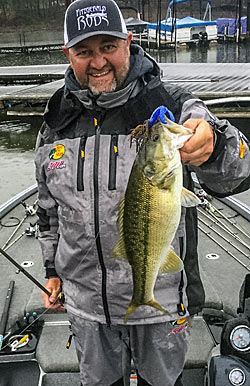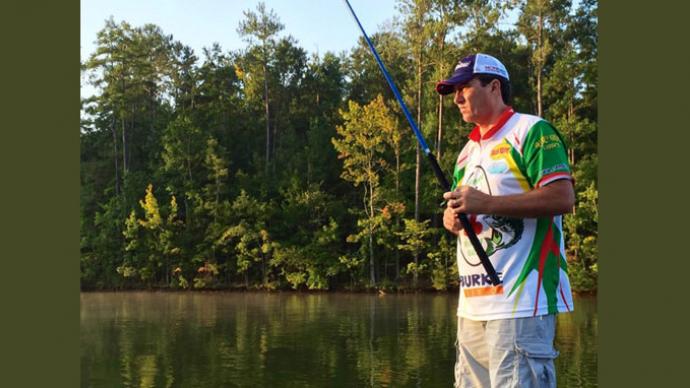
Dave Lefebre tasted bass-tournament victory many times on the local and regional levels, where bragging rights often outweigh payouts. Each was a step to the sport’s highest stage, which he reached in March 2004. That’s when the Erie, Pa., bass angler won the FLW Tour stop on Tennessee’s Old Hickory Lake, his first national title.
Old Hickory was extra stingy that week. No competitor caught a limit all four days; Lefebre came close, weighing four bass daily. But his efforts were more than enough, outdistancing second by nearly 9 pounds when it was over. Despite it only being his second visit to the fishery — he finished third in the championship for what’s now the Costa FLW Series the previous fall — he was confident, knowing how and where to fish, from the moment he arrived. He caught his bass cranking and flipping jigs in shallow water. They are techniques he long ago mastered, according to his notes.
Starting in the late 1970s, when he was still a little kid, Lefebre began a fishing log. “I kept it for 15 years,” he said. “I kept it religiously. I didn’t miss a day.” That was until the early 1990s when his focus turned to tournament fishing. But by then, he had assembled a massive amount of information, forming the foundation of his deep understanding of bass and the techniques used to catch them. Those lessons continue to drive his on-the-water decisions during past FLW Tour and Bassmaster Elite Series stints or future Major League Fishing endeavors. “I honestly believe [my current fishing success] goes back to that,” he said.
Fishing logs — a record of past fishing conditions and catches — are a time-tested way of learning to catch more and bigger bass. They are easy to keep, and reviewing them reveals how bass react to environmental conditions, seasons, and techniques. But their true power is unleashed when past information is used to make future fishing trips more successful. And to do that, you must read between the lines.
Getting the most from your fishing log
Some anglers struggle to slow down in today’s fast-paced world, making it difficult to invest the time in creating and reviewing a fishing log. Lefebre said they crave instant gratification, so they readily accept other anglers’ data, such as waypoints, as shortcuts. So, all is well if the hot tip they receive about a spot loaded with bass pans out. But what if it doesn’t? Without an understanding of why the bass were there and where they likely went, they’re done unless hunting and pecking around happens to uncover a bite or two. But that takes time and patience, both of which were in short supply initially.
It’s easy to stay in touch with bass if you know how they react to environmental changes. By comparing records of past trips in your fishing log, you’ll see patterns — specific combinations of location, lure, and time that produce bass — reveal themselves. And the more trips you record, the more precise these patterns become. Lefebre said you can drill down deep enough to predict how bass on a specific spot can be caught, whatever the current conditions. It’s all about using yesterday’s experiences to decide where to fish today.
A fishing log can never include too many details. “I kept everything I could,” Lefebre said. “I was a stat junky from the beginning.” He’d write down whatever he could measure or observe, including productive lures, weather, and water conditions. Having the correct information in your fishing log is essential for success. Each should include at least these for every trip:
- Weather and water conditions: Cold-blooded bass are entirely controlled by their environment. Water temperature, level, and clarity are the biggest influences on their activity and location. Air temperature, barometric pressure, wind, and sky conditions are not far behind.
- Size and number of bass: Write down how and where you catch every hawg and note the little bass, too. The latter can help establish spots and techniques for catching numbers, which are vital in tough tournaments when a small limit can have a big payoff.
- Lures and techniques: Record the weight, color, and size of productive lures. Don’t forget to include your retrieves, such as the cadence with jerkbaits, especially if you uncovered a trick. Use that information to assemble lure selections targeted to specific conditions. That way, you’ll spend more time casting and less wondering what to tie on next.
- Time and date: When you catch a bass is almost as important as where it happens. Bass use particular structure and cover at specific times, whether daily or seasonal.
- Notes and maps: Include helpful details such as which portions of the lake are busiest with summertime pleasure boaters or where logs and other dangerous floating debris collect after spring rains. Quickly sketched maps don’t have to be elaborate, just detailed enough to provide a reference while reviewing associated notes. It’s good to include GPS waypoints, whether you download their coordinates from your unit or transcribe them manually. That ensures you have them long after the unit is gone.
You must record the same information for every trip. That’s the only way you’ll be able to sort it, looking for similarities to build patterns around. If the weather forecast calls for sun and a stiff north wind, for example, you can go back into your log to review other trips with similar conditions, using what produced bass on those days to plan your attack.
Technological assist
When Lefebre started his log, fishing technology was primitive. Most anglers were lucky to have a flasher, which uses blips on a dial to reveal depth, bottom hardness, and fish. “We didn’t have GPS either,” he said. So, he would draw a grid over lake maps, lettering A through Z down the side and 1 to 100 across the top. Like in the board game “Battleship,” he would pinpoint each bass caught or particular spot uncovered with a letter-number coordinate. He also would triangulate those locations with shoreline objects such as trees or buildings, helping him find them again.
For years, fishing logs consisted of notebooks, three-ring binders, or manila folders crammed full of the types of handwritten documents that Lefebre created. And while that method is still a powerful approach, today’s anglers can store more data and analyze it better with modern technology such as GPS, home computers, and smartphones. It has even changed how they capture it.
Lefebre has helped a technology company develop a computer and mobile app that logs critical information from fishing trips. It captures your GPS route, catches, weather and water conditions, and more while incorporating online maps and aerial photos. When you return home, the app allows you to review the collected data and look for patterns and other information that will help with future trips. You can even share the information with your fishing buddies.
Too much of a good thing
Bass fishing success is a moving target. At the same time, seasonal movements and environmental changes are a constant, and the playing field changes, sometimes at a moment’s notice. Rivers can cut new courses, shallow spots become silted, and aquatic vegetation beds grow, shrink, and sometimes disappear. So, while it’s essential to use a fishing log to develop reliable big-picture information, some wiggle room needs to be incorporated into your approach. How much is up to you, but FLW Tour pro David Williams likes as much as he can.
Williams has had a chance to write volumes of fishing logs from his time fishing local and regional tournaments near his Maiden, N.C., home, which is about a long cast from Lake Norman, traveling for Bassmaster Opens, competing for three seasons on the Bassmaster Elite Series and starting with the FLW Tour, where his first tour-level win came on Alabama’s Lewis Smith Lake in April 2018. But he chooses to never jot down any information from those events or other fishing trips when largemouth and spotted bass are his targets.
It’s not that there isn’t any valuable information gained from those trips. What concerns Williams is falling into the trap of fishing spots and techniques that aren’t matched to current conditions. “I don’t like to fish on history at all,” he said. And he has good reason: He can trace most of his worst tournament finishes back to attempting to replicate a pattern that worked yesterday exactly.
Williams keeps an open mind while fishing, applying bass fishing’s basic rules to the conditions he encounters daily. If he’s competing in an April tournament on a lake that he has only fished in October, for example, he doesn’t want to be sucked into fishing springtime spots when bass are doing autumnal things such as schooling on baitfish. He never keeps waypoints when he’s fishing for largemouth.
Williams makes an exception to his no-waypoints rule when he heads north to fish for smallmouth. They will use the same current breaks, such as ledges, shoals, and even sunken boats, every year. So, they are worth remembering, and the easiest way to do that is by dropping a GPS waypoint on each.



